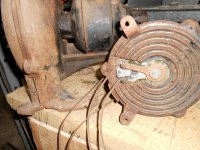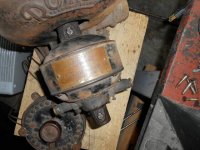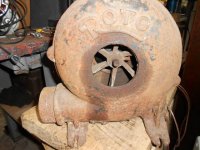John:
Most of the old electric forge blowers had what are termed "Universal" motors, a type which you, as an electrical engineer are likely well familiar with. It is the same type motor as is used on some power tools such as drills and saws. The nameplates on the old forge blower motors often read for "current": AC/DC; or; DC-60 cycles (covers all the bases including the old 25 hz AC or districts where the only power available was DC).
I got a Variac made in Bristol, Connecticut, off ebay in excellent overall condition for 50 bucks. It does the job and is what a lot of our local blacksmiths use for forge blower speed control. A Variac is a variable output transformer, so the speed control is stepless. An idea I had, if I did not score a Variac, was to use a heavy-duty lighting dimmer. These are a silicon controlled rectifier and potentiometer, and put out what is likely half-wave DC at variable voltages. I've seen some blacksmith forges with the old blowers wired to lighting dimmers. Looks kind of out of place, but it obviously works.
The Variac, while not a classic old forge blower speed control or the big rheostat as in this thread, at least has a molded Bakelite knob and pointer and looks a bit more appropriate at the forge. The Kirby vacuum cleaner blower is at least as old as I am (66), and I've built a mounting for it that utilizes attachment points on the blower and motor casings. I'm going to cheat a bit and use a "Fernco" molded rubber drainage pipe coupling to tie the blower discharge to the blast pipe of the forge.
Finding anything with a genuine universal type motor is getting a bit harder these days. Universal motors used to be a lot more common on small appliances, power tools, and on smaller machines. I've got a heater out of the cab of an ALCO diesel locomotive that was being scrapped. The heater is basically a hot water/forced air heater. It has a 32 volt DC motor. I plan to hang the heater in part of my shop, but I do not want to get rid of the original motor. Plenty of rectifier bridges are available on ebay for small money, but finding a transformer with a 32 volt output is elusive. The name of the locomotive cab heater is wishful thinking (knowing how cold an old locomotive cab can be in winter): it is called the "Hades Heater". I think it will be kind of classy to heat an area of my shop with an old locomotive cab heater, so will be building a dedicated DC power supply. Up on the locomotive, there was a box with a simple rheostat to vary the fan speed, but like a dummy, I did not grab it.
I like the old universal motors. A brush type motor with a commutator and the faint smell of ozone is one of those things that can take a man of my age back in time.















